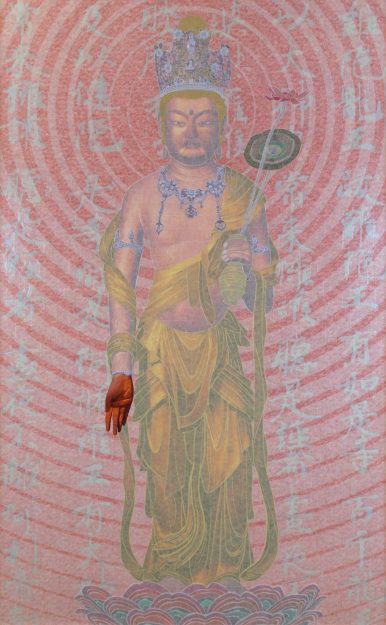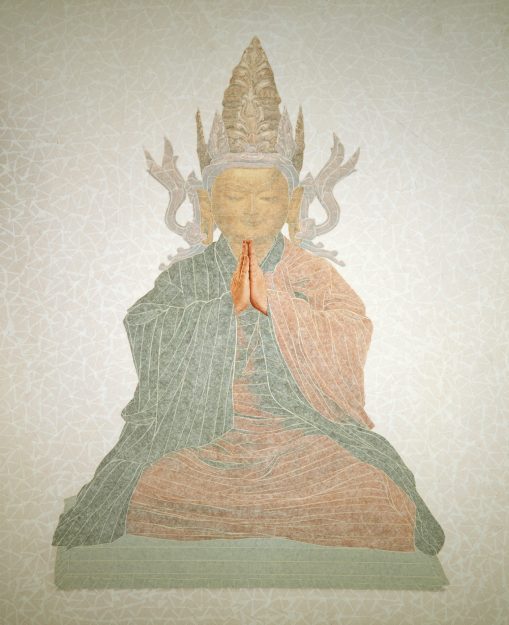Photographer Patrick Nagatani (1945–2017) lived his life in search of magic and enchantment. He saw photography not as a means to capture a stable truth but to challenge viewers’ perceptions of reality. He described his approach as dwelling in “an ironic state of middle ground,” seeking the possibilities that exist between fact and fiction. Over the course of his wide-ranging career, Nagatani continually tested the limits of the medium through his investigations into history and memory, explorations of healing rituals, and vivid and unsettling portraits of the nuclear age.

Born just days after an atomic bomb decimated his family’s hometown of Hiroshima, Nagatani dedicated much of his life to raising awareness about the catastrophic impact of nuclear weapons research. His parents, both incarcerated during World War II, met in an early-release program in Chicago in 1944. After Nagatani was born, the family moved to Los Angeles, where Nagatani worked in Hollywood building special-effects models and later earned an MFA in photography at UCLA. As a photographer, he drew on his film experience to push the conventional boundaries of the art form by constructing elaborate narrative tableaux and working in what he called the “directorial mode.”


Nagatani’s most famous series, “Nuclear Enchantment,” drew attention to the disastrous consequences of New Mexico’s nuclear industry. Through theatrical hand-colored photo collages, the series documents nuclear test sites, uranium mines, and Native American lands contaminated by radioactive pollution. Against the backdrop of each site, he juxtaposed scenes of polluted skies and atomic explosions with ancient mythic figures to create surreal visions of nuclear apocalypse. In one image, a masked Nagatani stands at the Trinity test site holding an umbrella as pieces of Trinitite rain down; in another, Pueblo sacred clowns dance amidst the missiles at White Sands against an eerily yellow sky. “Like the macabre yet jewel-like images from medieval books of hours dealing with the Office of the Dead,” Nagatani wrote, “I point a boney finger at the contemporary dance of death we are on the verge of joining.”
In 1993, Nagatani turned to the history of Japanese American imprisonment during World War II. In this project, he viewed himself as “part historian, archaeologist, geologist, cartographer, photographer, and Japanese American sansei” investigating his own cultural identity. Guided by the belief that landscapes retain memory, Nagatani undertook a pilgrimage to the sites of ten major camps, searching through the debris for remnants of the lives of those who were incarcerated there. With this series, he eschewed his previous flamboyance in favor of stark, unmanipulated photographs of the camps’ abandoned artifacts, as he wanted the images to speak for themselves about the cruelty of forced relocation and incarceration.
“Time passes, and only my aching fingers and shoulders indicate how long I have been continuously painting with the tape.”
In 2000, after his parents died, Nagatani became more interested in Buddhism and embarked on his “Buddhist Tape/estries” series. Through speaking with his parents’ Buddhist monk, he learned more about Buddhist iconography, and he was especially drawn to the use of mudras—ritual hand gestures—to convey meaning. To create the “tape/estries,” Nagatani applied thousands of pieces of masking tape to chromogenic LightJet photographs of buddhas and bodhisattvas, taping for hours at a time to create intricately layered compositions. He described the taping process as obsessive, and he likened it to a state of meditative absorption: “Time passes, and only my aching fingers and shoulders indicate how long I have been continuously painting with the tape.” Nagatani chose tape because he saw it as an “inexpensive and somewhat castaway” art material that would deteriorate over time, and he viewed each piece as “an evolving entity with the spirit of permanence and impermanence interwoven into the materials used.”

The notion of impermanence took on new meaning for Nagatani when he was diagnosed with colon cancer in 2005. As he underwent treatment, he took a more active interest in healing practices, experimenting with ancient rituals like chromotherapy, or the use of colored light for healing purposes. He continued to reinvent himself in his pursuit of magic, testing the bounds of truth and reality, until his death in 2017.

